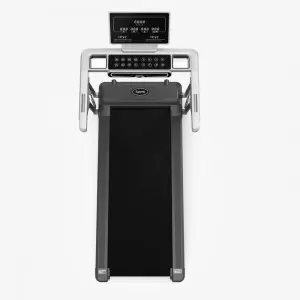The treadmill is not only a good helper for fitness, but also an effective tool for rehabilitation training. Whether it’s post-operative recovery, joint injury rehabilitation, or chronic disease management, treadmills provide a safe, controlled environment for exercise. Here is a practical guide to using the treadmill for rehabilitation training.
1. Preparation before rehabilitation training
Always consult a doctor or physical therapist before starting rehabilitation to make sure the exercise program is appropriate for your condition. In addition, note that:
Choose the right treadmill: Choose a treadmill with a cushioning system and an adjustable slope to reduce impact on your joints.
Wear the right sports shoes: Choose sports shoes with good support and shock absorption to protect your feet and knees.
Warm up exercise: Perform a 5-10 minute warm up, such as stretching or slow walking, to activate muscles and joints.
2. Specific methods of rehabilitation training
Depending on the rehabilitation goals and individual circumstances, the following training methods can be selected:
(1) Walking training
Suitable for: postoperative recovery, joint injury or long-term lack of exercise.
Method: Set the treadmill speed to 2-4 km/h, adjust the slope to 0%, walk for 10-20 minutes each time, gradually increase the time and speed.
Note: Keep your body upright and avoid over-reliance on handrails.
(2) Low intensity jogging
Suitable for: patients with weak cardiopulmonary function or chronic diseases.
Method: Set the speed to 4-6 km/h, adjust the slope to 1-2%, and jog for 15-30 minutes each time.
Note: Control the heart rate within a safe range (usually 50-70% of the maximum heart rate).
(3) Slope walking
Suitable for: knee rehabilitation or lower limb strength training.
Method: Set the speed to 3-5 km/h, adjust the slope to 5-10%, and train for 10-15 minutes each time.
Note: The slope should not be too high to avoid excessive pressure on the knee.
(4) Interval training
Suitable for: those who need to improve cardiopulmonary function or metabolic capacity.
Method: Alternate between fast walking and slow walking, such as fast walking for 1 minute (speed 5-6 km/h), slow walking for 2 minutes (speed 3-4 km/h), repeat 5-10 times.
Note: Adjust the strength according to the state of the body to avoid excessive fatigue.
3. Precautions for rehabilitation training
Step by step: Start with low intensity and short time and gradually increase the amount of exercise.
Monitor physical reactions: If you experience pain, dizziness, or difficulty breathing, stop training immediately and consult a doctor.
Maintain proper posture: Stand upright, look ahead, swing your arms naturally, and avoid bending over or over-relying on armrests.
Evaluate progress regularly: Adjust the training plan according to the rehabilitation effect to ensure scientific and safe.
4. Relaxation after rehabilitation training
After training, do 5-10 minutes of relaxation activities, such as slow walking or stretching, to help the body gradually return to a calm state. In addition, proper hydration and nutrition promote body recovery.
Conclusion
Treadmill provides a safe and controllable environment for rehabilitation training, which is suitable for people with different rehabilitation needs. Through scientific training methods and reasonable planning, treadmills can not only speed up the rehabilitation process, but also improve the overall level of health. Under the guidance of a doctor or professional coach, make reasonable use of the treadmill to make your road to recovery more efficient and secure.
Post time: Mar-20-2025




